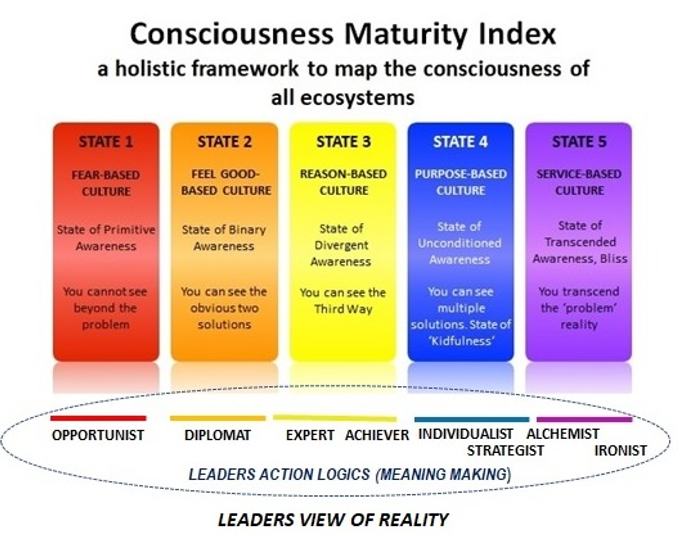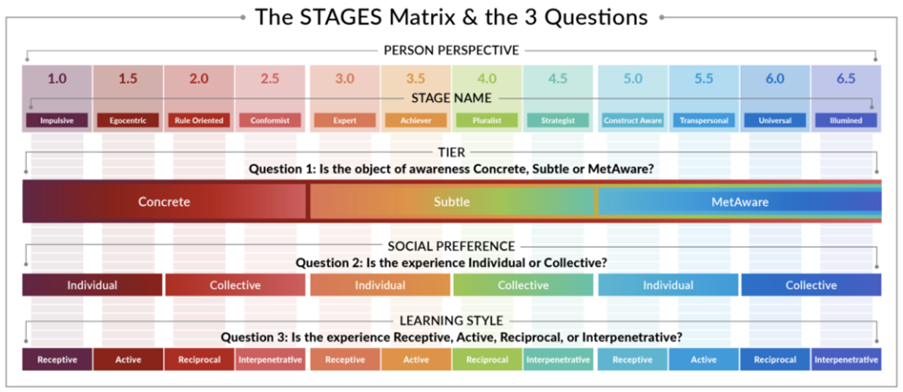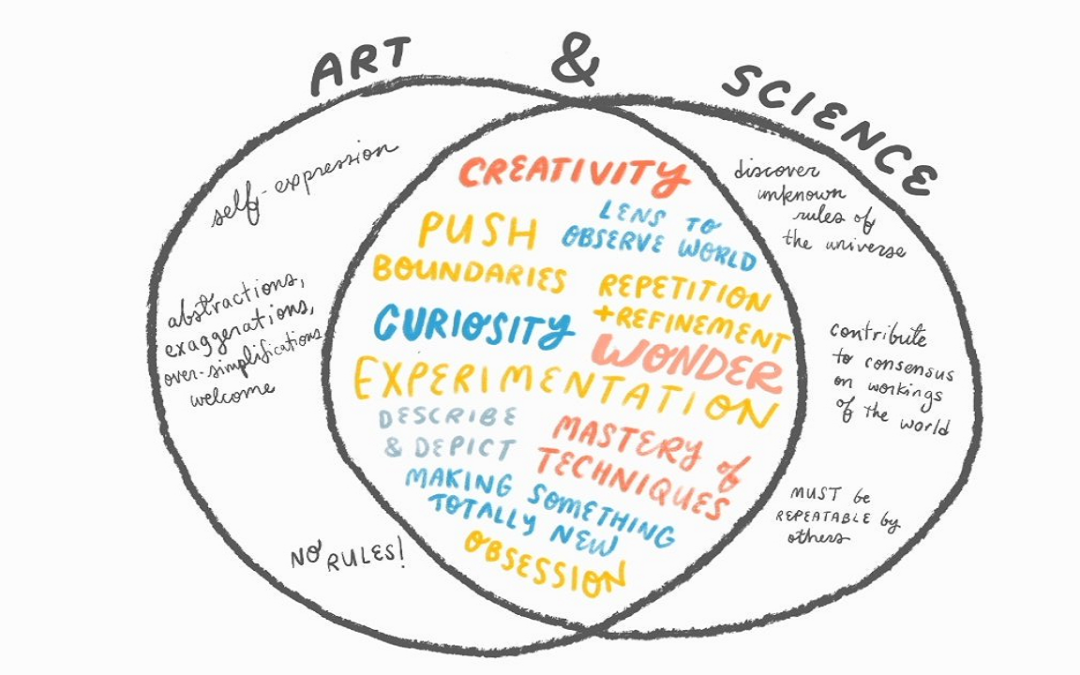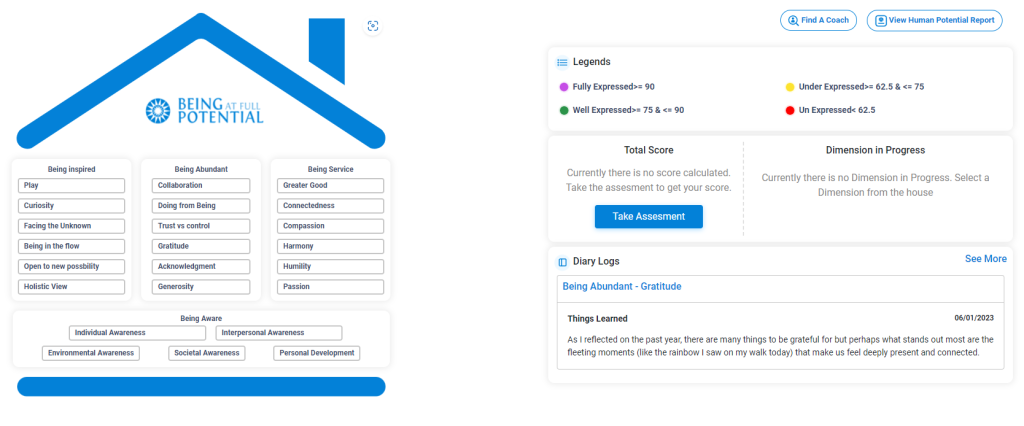As more and more people are starting to realize that Inner Development & growth is a pre-requisite to achieving the change we want to see in the outside world (for example Sustainable Development Goals), our work at BEING at Full Potential is becoming increasingly relevant but also more closely scrutinized.
The following article was written in response to the many inquiries we are receiving about the research foundations of the Human Potential Assessment tool and how it relates to existing models of adult development. Most of the credit for this compilation goes to Peter Leong who has always looked at what we do through the lens of leading-edge research in the field of ego development and leadership maturity. He is a master at connecting the dots between our ground up, experimental approach to wisdom skill development and the more scientific method followed by people like Terri O’Fallon, Susanne Cook-Greuter, Ph.D. and William Torbert.
At the intersection of ART and SCIENCE lies something beautiful that cannot be fully explained by the rational mind, but in our hearts, we know it resonates as being deeply true. We hope you will enjoy learning more about our slightly unconventional, but intuitive and holistic, “road to validation”. By no means have we fully arrived, and it’s unlikely that we ever will be able to capture the expansiveness of human consciousness in the well-defined confines of science, but the journey in itself continues to be a worthwhile one.
Background
- The idea for the Human Potential Tool was born in 2013 to address the need for vertical growth & development (BEING leadership) in a world dominated by tools focusing on horizontal development (DOING leadership).
- It was the lived life experiences of Mark Vandeneijnde and Sujith Ravindran that informed the initial foundations of the model. Seeing so many people (including themselves) experience a lack of meaning and purpose in their lives & work inspired them to ask the simple question: “How much potential is being wasted and what does it take to unleash it”? They knew that even 1% improvement in potential utilization would significantly impact our ability to address the increasingly complex challenges we face in organizations and society at large.
- Having decided to take on the challenge of “measuring the immeasurable” they spent 6 months mapping out all the available knowledge (latest research on consciousness, adult development, management theory, mystical traditions…). Combining that with their own personal awakenings, a map started to emerge which eventually took the shape of a house with 4 states and 23 dimensions as well as the 83 questions needed to reveal these deeper human insights.
- Unlike other behavioral, cognitive, and personality assessments that are usually “normative” – observed external behavior and actions of a large sample size of people (bell-curve) and grouping them into behavioral norms, the approach we took was developed “from the ground up”. It’s part art, part science attempting to bring more depth, heart, intuition & spirit into a world overly consumed by the rational mind.
The Portal for Human Potential Development
Validation & reliability – empirical research
- Our first confirmation that the tool “does what it is supposed to do” (ie: validation) came in 2014 after presenting the results of our first pilot project. The client experienced the results as a mirror of what they knew to be true about their organization, but until then hadn’t been able to clearly articulate. In other words, it was confirming their intuition and making it more tangible by generating new conversations with new words, language and symbols. In this way it could be discussed and acted on in more objective ways (as per the old adage: “What gets measured, gets done”).
- Over the years our confidence in the tool only grew through experience, practice and many generative conversations. Both at individual and organizational level we continued to see how it was able to reveal deeper layers of the human condition, open up transformational conversations and correlate with more conventional performance metrics.
- We now have 8000+ users of the tool and multiple organizations who have done measurements over different periods of time. These pre / post projects and case studies have given us additional confidence in the reliability of the tool (ie: it’s ability to produce stable and consistent results over a period of time)
Validation & reliability – conceptual research
When Peter Leong came on board, he brought years of experience in adult development and consciousness research. Looking at the Human Potential tool from this perspective he helped us “connect the dots backwards” and realize that this experimental creation was deeply in sync with state-of-the-art research (and therefore not surprising that we see so much overlap with important initiatives like the Inner Development Goals). Here are some of the many connection points:
The Spectrum of Consciousness (Ken Wilber)
The Spectrum of Consciousness is a unique approach to the study of human identity which synthesizes psychology, psychotherapy, mysticism, world religions (spirituality), and enlightenment. It demonstrates that different approaches to the study of consciousness can be “integrated and synthesized into one spectrum, one rainbow.” Ken’s model of consciousness not only sensibly unites mysticism and Eastern and Western psychologies in general, but it also clarifies various Western approaches to psychotherapy. And like enlightenment itself, it illuminates them all while transcending them all. (adapted from Ken Wilber – The Spectrum of Consciousness)

Torbert’s theory of adult development & the seven developmental action logics
This image gives a high-level view of how we may apply the Being at Full Potential 5 state maturity framework to leadership action logic. We can also adapt the Being at Full Potential framework and metrics to other consciousness maturity maps like the 12 stages of development by Terri O’Fallon, founder of Stages International

We can also adapt the Being at Full Potential framework and metrics to other consciousness maturity maps like the 12 stages of development by Terri O’Fallon, founder of Stages International. This overlay is available on request. The image below shows the Stages International 12 stages of Person Perspective and the 3 Questions.

12 Stages Model
Validation & reliability – there is no holy grail
No matter how advanced and “scientifically validated” a tool is, when it comes to consciousness or maturity development, the deeper sense making will always happen through a process of inner reflection or dialogue with others. Tools aspiring to add value in the expansive field of human consciousness can never claim to have “the” answer or solution for somebody’s growth and development. At best, they can be mirrors to see oneself in a more holistic way and open up targeted conversations that bring out the important insights for a person’s next steps.
This is why our method for deploying the results of the Human Potential assessment takes great care at putting the client at the center of the discovery process. We do this in the following way:
- The Human Potential Tool is invaluable for generating transformational conversations to change or shift the social reality by enabling people “to see the world through fresh eyes”. Since we cannot solve and achieve sustainable change with the same level of consciousness that created the unstainable problem (paraphrasing Einstein’s famous quote), a new level of seeing and constructing a higher social reality with more expansive “mental constructs” is needed (see slide 9).
- Therefore, the tool needs to have trained and certified change facilitators capable of creating safe containers where people can expand their thinking and engage in deep generative conversations. From this place we invite our clients to take the lead in discovering the story in their data (vs come in as experts with conclusions and recommendations). This unique methodology leads much greater levels of insight, ownership and accountability with the client.
- In other words, the Human Potential tool, when used in a generative change process, comes complete with a practical methodology (assessment and sensing, subtracting, passaging, arriving and harnessing). It is an emergent change process. It is not a set of instructions for what to achieve. Sustainable change is emergent in nature (systems theory – sensing and seeing that the whole is greater than the sum of all its parts – seeing wholeness as an approach).
Conclusion
At the intersection of ART and SCIENCE lies something beautiful that cannot be fully explained by the rational mind, but in our hearts, we know it resonates as being deeply true. We hope you have enjoyed learning more about our slightly unconventional “road to validation” through the intuitive and holistic lens. By no means have we fully arrived, and it’s unlikely that we ever will be able to capture the expansiveness of human consciousness in the well-defined confines of science, but the journey in itself continues to be a worthwhile one. For more information about BEING at Full Potential and our services please contact Mark Vandeneijnde or Peter Leong.


